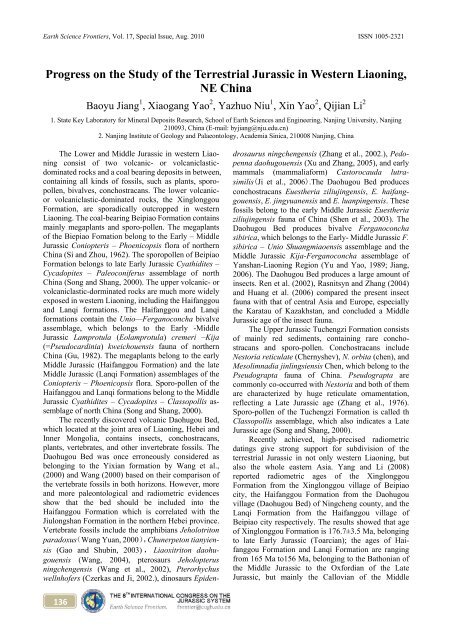in Jurassic and Cretaceous Stratigraphy
in Jurassic and Cretaceous Stratigraphy
in Jurassic and Cretaceous Stratigraphy
You also want an ePaper? Increase the reach of your titles
YUMPU automatically turns print PDFs into web optimized ePapers that Google loves.
Earth Science Frontiers, Vol. 17, Special Issue, Aug. 2010 ISSN 1005-2321<br />
Progress on the Study of the Terrestrial <strong>Jurassic</strong> <strong>in</strong> Western Liaon<strong>in</strong>g,<br />
NE Ch<strong>in</strong>a<br />
136<br />
Baoyu Jiang 1 , Xiaogang Yao 2 , Yazhuo Niu 1 , X<strong>in</strong> Yao 2 , Qijian Li 2<br />
1. State Key Laboratory for M<strong>in</strong>eral Deposits Research, School of Earth Sciences <strong>and</strong> Eng<strong>in</strong>eer<strong>in</strong>g, Nanj<strong>in</strong>g University, Nanj<strong>in</strong>g<br />
210093, Ch<strong>in</strong>a (E-mail: byjiang@nju.edu.cn)<br />
2. Nanj<strong>in</strong>g Institute of Geology <strong>and</strong> Palaeontology, Academia S<strong>in</strong>ica, 210008 Nanj<strong>in</strong>g, Ch<strong>in</strong>a<br />
The Lower <strong>and</strong> Middle <strong>Jurassic</strong> <strong>in</strong> western Liao-<br />
n<strong>in</strong>g consist of two volcanic- or volcaniclastic-<br />
dom<strong>in</strong>ated rocks <strong>and</strong> a coal bear<strong>in</strong>g deposits <strong>in</strong> between,<br />
conta<strong>in</strong><strong>in</strong>g all k<strong>in</strong>ds of fossils, such as plants, sporo-<br />
pollen, bivalves, conchostracans. The lower volcanic-<br />
or volcaniclastic-dom<strong>in</strong>ated rocks, the X<strong>in</strong>glonggou<br />
Formation, are sporadically outcropped <strong>in</strong> western<br />
Liaon<strong>in</strong>g. The coal-bear<strong>in</strong>g Beipiao Formation conta<strong>in</strong>s<br />
ma<strong>in</strong>ly megaplants <strong>and</strong> sporo-pollen. The megaplants<br />
of the Biepiao Fomation belong to the Early – Middle<br />
<strong>Jurassic</strong> Coniopteris – Phoenicopsis flora of northern<br />
Ch<strong>in</strong>a (Si <strong>and</strong> Zhou, 1962). The sporopollen of Beipiao<br />
Formation belongs to late Early <strong>Jurassic</strong> Cyathidites –<br />
Cycadopites – Paleoconiferus assemblage of north<br />
Ch<strong>in</strong>a (Song <strong>and</strong> Shang, 2000). The upper volcanic- or<br />
volcaniclastic-dorm<strong>in</strong>ated rocks are much more widely<br />
exposed <strong>in</strong> western Liaon<strong>in</strong>g, <strong>in</strong>clud<strong>in</strong>g the Haifanggou<br />
<strong>and</strong> Lanqi formations. The Haifanggou <strong>and</strong> Lanqi<br />
formations conta<strong>in</strong> the Unio—Ferganoconcha bivalve<br />
assemblage, which belongs to the Early -Middle<br />
<strong>Jurassic</strong> Lamprotula (Eolamprotula) cremeri –Kija<br />
(=Pseudocard<strong>in</strong>ia) kweichouensis fauna of northern<br />
Ch<strong>in</strong>a (Gu, 1982). The megaplants belong to the early<br />
Middle <strong>Jurassic</strong> (Haifanggou Formation) <strong>and</strong> the late<br />
Middle <strong>Jurassic</strong> (Lanqi Formation) assemblages of the<br />
Coniopteris – Phoenicopsis flora. Sporo-pollen of the<br />
Haifanggou <strong>and</strong> Lanqi formations belong to the Middle<br />
<strong>Jurassic</strong> Cyathidites – Cycadopites – Classopollis as-<br />
semblage of north Ch<strong>in</strong>a (Song <strong>and</strong> Shang, 2000).<br />
The recently discovered volcanic Daohugou Bed,<br />
which located at the jo<strong>in</strong>t area of Liaon<strong>in</strong>g, Hebei <strong>and</strong><br />
Inner Mongolia, conta<strong>in</strong>s <strong>in</strong>sects, conchostracans,<br />
plants, vertebrates, <strong>and</strong> other <strong>in</strong>vertebrate fossils. The<br />
Daohugou Bed was once erroneously considered as<br />
belong<strong>in</strong>g to the Yixian formation by Wang et al.,<br />
(2000) <strong>and</strong> Wang (2000) based on their comparison of<br />
the vertebrate fossils <strong>in</strong> both horizons. However, more<br />
<strong>and</strong> more paleontological <strong>and</strong> radiometric evidences<br />
show that the bed should be <strong>in</strong>cluded <strong>in</strong>to the<br />
Haifanggou Formation which is correlated with the<br />
Jiulongshan Formation <strong>in</strong> the northern Hebei prov<strong>in</strong>ce.<br />
Vertebrate fossils <strong>in</strong>clude the amphibians Jeholotriton<br />
paradoxus(Wang Yuan, 2000),Chunerpeton tianyien-<br />
sis (Gao <strong>and</strong> Shub<strong>in</strong>, 2003) , Liaoxitriton daohu-<br />
gouensis (Wang, 2004), pterosaurs Jeholopterus<br />
n<strong>in</strong>gchengensis (Wang et al., 2002), Pterorhychus<br />
wellnhofers (Czerkas <strong>and</strong> Ji, 2002.), d<strong>in</strong>osaurs Epiden-<br />
drosaurus n<strong>in</strong>gchengensis (Zhang et al., 2002.), Pedo-<br />
penna daohugouensis (Xu <strong>and</strong> Zhang, 2005), <strong>and</strong> early<br />
mammals (mammaliaform) Castorocauda lutra-<br />
similis(Ji et al., 2006).The Daohugou Bed produces<br />
conchostracans Euestheria ziliuj<strong>in</strong>gensis, E. haifang-<br />
gouensis, E. j<strong>in</strong>gyuanensis <strong>and</strong> E. luanp<strong>in</strong>gensis. These<br />
fossils belong to the early Middle <strong>Jurassic</strong> Euestheria<br />
ziliuj<strong>in</strong>gensis fauna of Ch<strong>in</strong>a (Shen et al., 2003). The<br />
Daohugou Bed produces bivalve Ferganoconcha<br />
sibirica, which belongs to the Early- Middle <strong>Jurassic</strong> F.<br />
sibirica – Unio Shuangmiaoensis assemblage <strong>and</strong> the<br />
Middle <strong>Jurassic</strong> Kija-Ferganoconcha assemblage of<br />
Yanshan-Liaon<strong>in</strong>g Region (Yu <strong>and</strong> Yao, 1989; Jiang,<br />
2006). The Daohugou Bed produces a large amount of<br />
<strong>in</strong>sects. Ren et al. (2002), Rasnitsyn <strong>and</strong> Zhang (2004)<br />
<strong>and</strong> Huang et al. (2006) compared the present <strong>in</strong>sect<br />
fauna with that of central Asia <strong>and</strong> Europe, especially<br />
the Karatau of Kazakhstan, <strong>and</strong> concluded a Middle<br />
<strong>Jurassic</strong> age of the <strong>in</strong>sect fauna.<br />
The Upper <strong>Jurassic</strong> Tuchengzi Formation consists<br />
of ma<strong>in</strong>ly red sediments, conta<strong>in</strong><strong>in</strong>g rare concho-<br />
stracans <strong>and</strong> sporo-pollen. Conchostracans <strong>in</strong>clude<br />
Nestoria reticulate (Chernyshev), N. orbita (chen), <strong>and</strong><br />
Mesolimnadia j<strong>in</strong>l<strong>in</strong>gsiensis Chen, which belong to the<br />
Pseudograpta fauna of Ch<strong>in</strong>a. Pseudograpta are<br />
commonly co-occurred with Nestoria <strong>and</strong> both of them<br />
are characterized by huge reticulate ornamentation,<br />
reflect<strong>in</strong>g a Late <strong>Jurassic</strong> age (Zhang et al., 1976).<br />
Sporo-pollen of the Tuchengzi Formation is called th<br />
Classopollis assemblage, which also <strong>in</strong>dicates a Late<br />
<strong>Jurassic</strong> age (Song <strong>and</strong> Shang, 2000).<br />
Recently achieved, high-precised radiometric<br />
dat<strong>in</strong>gs give strong support for subdivision of the<br />
terrestrial <strong>Jurassic</strong> <strong>in</strong> not only western Liaon<strong>in</strong>g, but<br />
also the whole eastern Asia. Yang <strong>and</strong> Li (2008)<br />
reported radiometric ages of the X<strong>in</strong>glonggou<br />
Formation from the X<strong>in</strong>glonggou village of Beipiao<br />
city, the Haifanggou Formation from the Daohugou<br />
village (Daohugou Bed) of N<strong>in</strong>gcheng county, <strong>and</strong> the<br />
Lanqi Formation from the Haifanggou village of<br />
Beipiao city respectively. The results showed that age<br />
of X<strong>in</strong>glonggou Formation is 176.7±3.5 Ma, belong<strong>in</strong>g<br />
to late Early <strong>Jurassic</strong> (Toarcian); the ages of Hai-<br />
fanggou Formation <strong>and</strong> Lanqi Formation are rang<strong>in</strong>g<br />
from 165 Ma to156 Ma, belong<strong>in</strong>g to the Bathonian of<br />
the Middle <strong>Jurassic</strong> to the Oxfordian of the Late<br />
<strong>Jurassic</strong>, but ma<strong>in</strong>ly the Callovian of the Middle

















